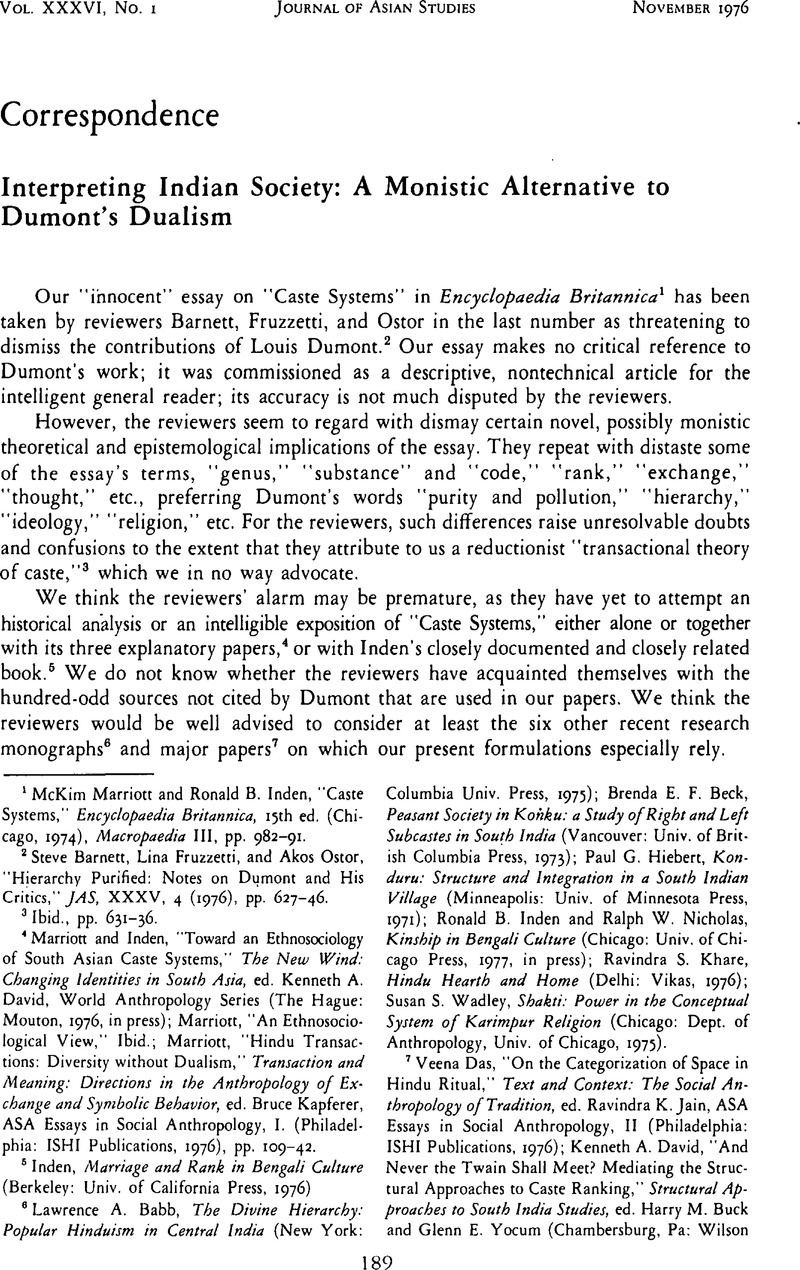Published online by Cambridge University Press: 23 March 2011

1 McKim Marriott and Inden, Ronald B., “Caste Systems,” Encyclopaedia Britannica, 15th ed. (Chicago, 1974)Google Scholar, Macropaedia III, pp. 982–91.
2 Barnett, Steve, Fruzzetti, Lina, and Ostor, Akos, “Hierarchy Purified: Notes on Dumont and His Critics,” JAS, XXXV, 4 (1976), pp. 627–46CrossRefGoogle Scholar.
3 Ibid., pp. 631–36.
4 Marriott and Inden, “Toward an Ethnosociology of South Asian Caste Systems,” The New Wind: Changing Identities in South Asia, ed. Kenneth A. David, World Anthropology Series (The Hague: Mouton, 1976, in press); Marriott, “An Ethnosocio-logical View,” Ibid.; Marriott, “Hindu Transactions: Diversity without Dualism,” Transaction and Meaning: Directions in the Anthropology of Exchange and Symbolic Behavior, ed. Bruce Kapferer, ASA Essays in Social Anthropology, I. (Philadelphia: ISHI Publications, 1976), pp. 109–42.
5 Inden, Marriage and Rank in Bengali Culture (Berkeley: Univ. of California Press, 1976)
6 Babb, Lawrence A., The Divine Hierarchy: Popular Hinduism in Central India (New York: Columbia Univ. Press, 1975)Google Scholar; Beck, Brenda E. F., Peasant Society in Konku: a Study of Right and Left Subcastesin South India (Vancouver: Univ. of British Columbia Press, 1973)Google Scholar; Hiebert, Paul G., Kon-duru: Structure and Integration in a South Indian Village (Minneapolis: Univ. of Minnesota Press, 1971)Google Scholar; Inden, Ronald B. and Nicholas, Ralph W., Kinship in Bengali Culture (Chicago: Univ. of Chicago Press, 1977, in press)Google Scholar; Khare, Ravindra S., Hindu Hearth and Home (Delhi: Vikas, 1976)Google Scholar; Wadley, Susan S., Shakti: Power in the Conceptual System of Karimpur Religion (Chicago: Dept. of Anthropology, Univ. of Chicago, 1975)Google Scholar.
7 Das, Veena, “On the Categorization of Space in Hindu Ritual,” Text and Context: The Social Anthropology of Tradition, ed. Jain, Ravindra K., ASA Essays in Social Anthropology, II (Philadelphia: ISHI Publications, 1976)Google Scholar; David, Kenneth A., “And Never the Twain Shall Meet? Mediating the Structural Approaches to Caste Ranking,” Structural Approaches to South India Studies, ed. Buck, Harry M. and Yocum, Glenn E. (Chambersburg, Pa: Wilson Books, 1974), pp. 43–80Google Scholar, and “Hierarchy and Equivalence in Jaffna, North Ceylon: Normative Codes as Mediator,” The New Wind; Davis, Marvin G., “A Philosophy of Hindu Rank from Rural West Bengal,” JAS, XXXVI, 1 (1976), pp. 5–24CrossRefGoogle Scholar; Tambiah, Stanley J., “From Varna to Caste Through Mixed Unions,” The Character of Kinship, ed. Goody, Jack (Cambridge: Cambridge Univ. Press, 1974), pp. 191–229CrossRefGoogle Scholar; Trawick, Margaret, “Principles of Continuity in Three Indian Sciences: Psychology of Samkhya and Yoga, Biology of Āyurveda, Sociology of Dharmasāstra and Their Concentric Domains,” M.A. paper in Anthropology, Univ. of Chicago, 1974Google Scholar.
8 “Caste, Racism and ‘Stratification’: Reflect jons of a Social Anthropologist,” Contributions to Indian Sociology [hereafter CIS], V (1961), pp. 39–40.
9 Ibid., p. 36.
10 “The Conception of Kingship in Ancient India,” CIS, VI (1962), esp. pp. 48–61Google Scholar.
11 cf. Tambiah, “From Varna to Caste.”
12 “Conception of Kingship,” pp. 64–65.
13 Ibid., p. 65.
14 Ibid., p. 61.
15 “For a Sociology of India,” CIS, I (1957), pp. 9–10Google Scholar.
16 “Conception of Kingship,” pp. 61–64, 67–68, 75–76.
17 “A. M. Hocart on Caste—Religion and Power,” CIS, II (1958), pp. 53–54Google Scholar.
18 “Conception of Kingship,” p. 52.
19 Dumont, Homo Hierarchies: The Caste System and Its Implications (Chicago: Univ. of Chicago Press, 1970), p. 49.
20 Dumont, “On Putative Hierarchy and Some Allergies to It,” CIS, n.s. V (1971), pp. 70–71.
21 Ibid., p. 76.
22 “Rajadharma,” JAS, XXXV, 4 (1976), pp. 599–611Google Scholar.
23 Wadley, Shakti.
24 “The Structural Position of a South Indian Caste,” Ph.D. dissertation, Univ. of Chicago, 1970.
25 Davis, “A Philosophy of Hindu Rank”; Heginbotham, Stanley J., Cultures in Conflict: The Four Faces of Indian Bureaucracy (New York: Columbia Univ. Press, 1975)Google Scholar; and others summarized by Marriott in “Hindu Transactions,” pp. 132–35.
26 “Putative Hierarchy,” p. 67, n. 28.
27 Szanton, David L., “South and Southeast Asia: New Concerns of the Council,” Social Science Research Council Items, XXX (1976), pp. 13–15Google Scholar.
28 Srinivas, M. N., Religion and Society among the Coorgs of South India (Oxford: The Clarendon Press, 1952)Google Scholar, esp. Chs. III–IV; Das, “Categorization of Space”; Khare, Hindu Hearth and Home.
29 Homo Hierarchicus, pp. 43, 50.
30 Inden, Marriage and Rank, pp. 19, 83; “Caste Systems,” p. 984; “Ethnosociology”; “Hindu Transactions,” pp. 123, 137.
31 Wadley, Shakti, Ch. V.
32 “Pure and Impure,” CIS, III (1959), p. 11Google Scholar.
33 “Hindu Transactions.”
34 Inden, Marriage and Rank, pp. 44–45; “Ethnosociology”; “Hindu Transactions.”
35 “Hierarchy Purified,” p. 632.